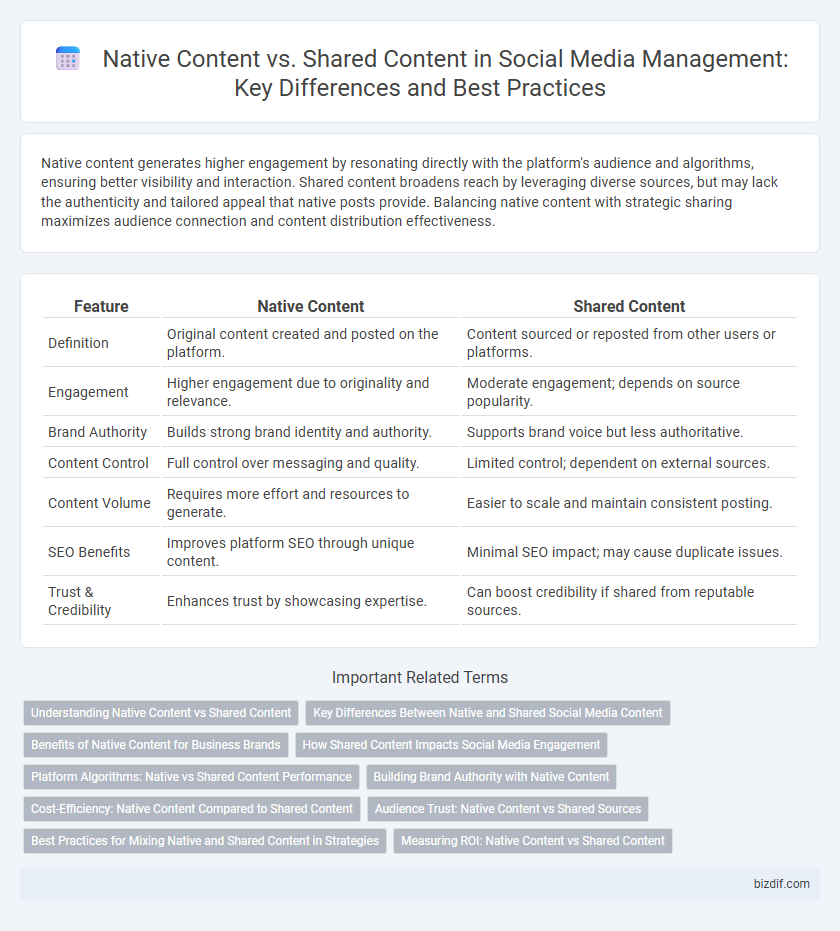Native content generates higher engagement by resonating directly with the platform's audience and algorithms, ensuring better visibility and interaction. Shared content broadens reach by leveraging diverse sources, but may lack the authenticity and tailored appeal that native posts provide. Balancing native content with strategic sharing maximizes audience connection and content distribution effectiveness.
Table of Comparison
| Feature | Native Content | Shared Content |
|---|---|---|
| Definition | Original content created and posted on the platform. | Content sourced or reposted from other users or platforms. |
| Engagement | Higher engagement due to originality and relevance. | Moderate engagement; depends on source popularity. |
| Brand Authority | Builds strong brand identity and authority. | Supports brand voice but less authoritative. |
| Content Control | Full control over messaging and quality. | Limited control; dependent on external sources. |
| Content Volume | Requires more effort and resources to generate. | Easier to scale and maintain consistent posting. |
| SEO Benefits | Improves platform SEO through unique content. | Minimal SEO impact; may cause duplicate issues. |
| Trust & Credibility | Enhances trust by showcasing expertise. | Can boost credibility if shared from reputable sources. |
Understanding Native Content vs Shared Content
Native content refers to original posts created specifically for a platform, designed to engage and resonate with its audience through tailored formats and messaging. Shared content involves redistributing existing posts or media from other users or sources, which helps increase reach and maintain consistent activity with less resource investment. Recognizing the balance between native and shared content is essential for optimizing social media strategies to drive authentic engagement and sustained audience growth.
Key Differences Between Native and Shared Social Media Content
Native social media content is created specifically for a platform, aligning with its format, audience behavior, and algorithms to maximize engagement and reach. Shared content involves reposting or distributing existing material from other sources, often to diversify feeds but with less control over customization or direct audience targeting. Understanding these key differences enables brands to strategically balance originality and curation for effective social media management.
Benefits of Native Content for Business Brands
Native content on social media enhances brand authenticity by seamlessly aligning with platform aesthetics and user expectations, resulting in higher engagement rates and improved trust. It drives better organic reach and visibility by leveraging algorithms favoring content that feels native rather than promotional. Businesses benefit from stronger audience connections and increased conversion potential through tailored storytelling that resonates naturally within users' feeds.
How Shared Content Impacts Social Media Engagement
Shared content amplifies social media engagement by expanding reach through diverse audience networks and fostering community interaction. Unlike native content, which builds brand identity, shared posts leverage external validation and trending topics, increasing visibility and credibility. Effective curation of shared content drives higher engagement rates by tapping into established interest groups and encouraging shares, comments, and discussions.
Platform Algorithms: Native vs Shared Content Performance
Native content on social media platforms generates higher engagement rates and gains preferential placement in platform algorithms due to its original format and tailored relevance. Shared content, while valuable for expanding reach, often receives lower algorithmic priority and reduced organic visibility compared to native posts. Prioritizing native content creation aligns with platform-specific algorithmic preferences, maximizing audience interaction and content discoverability.
Building Brand Authority with Native Content
Native content, created specifically for each social media platform, enhances brand authority by showcasing unique expertise and fostering authentic engagement with target audiences. Unlike shared content, which often lacks personalization and relevance, native content improves visibility through algorithm preference, driving higher organic reach and stronger customer trust. Investing in high-quality native posts positions brands as industry leaders, reinforcing their credibility and long-term influence in competitive markets.
Cost-Efficiency: Native Content Compared to Shared Content
Native content requires higher initial investment due to content creation and customization tailored to each platform, whereas shared content minimizes costs by repurposing existing materials across channels. Despite the upfront expenditure, native content often delivers greater engagement and brand authenticity, potentially leading to higher ROI over time. Shared content offers cost-efficiency through reduced production time and expenses but may result in lower audience resonance and diminished platform-specific relevance.
Audience Trust: Native Content vs Shared Sources
Native content generates higher audience trust by offering original, brand-specific insights that resonate authentically with followers. Shared content can enhance reach but risks diminishing credibility if sources appear unreliable or irrelevant. Prioritizing native content establishes stronger connections and reinforces brand authority in social media management strategies.
Best Practices for Mixing Native and Shared Content in Strategies
Effective social media management balances native content, which is original and platform-specific, with shared content that amplifies external sources and community voices. Best practices include scheduling native posts to reinforce brand identity while strategically sharing relevant third-party content to boost engagement and credibility. Utilizing analytics to monitor audience interaction guides the optimal mix, enhancing reach and fostering authentic connections across social channels.
Measuring ROI: Native Content vs Shared Content
Measuring ROI in social media management reveals that native content typically generates higher engagement rates and longer audience retention due to platform-specific algorithms favoring original posts. Shared content, while cost-effective and easier to distribute, often results in lower interaction metrics and diminished brand visibility. Leveraging analytics tools like Facebook Insights and Twitter Analytics can provide precise data comparing conversion rates and audience reach between native and shared content strategies.
Native content vs Shared content Infographic

 bizdif.com
bizdif.com